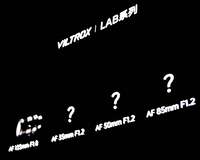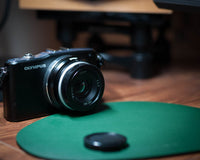Key Features:
- Same small size as a 550ml bottle of water
- Compatible with 90% of the mirrorless camera.
- Customized quick release design. Swap batteries without rebalancing.
- Built-in LED fill light. 800 Lumens.
- Connection with professional microphone.
Price:
$399 - $449 - $649
Extra 5% Discount: CDBWTKHHVF54
Desgin
The Crane M3 continued the grasp design of Crane M2, but with a great creativity in the color design, it is no longer a single black, but a mixture of black and white, the first look is stylish and good-looking, this special color design makes it can be easily distinguished in many stabilizers. At the same time, it is very compact, easy to storage and carry. It is about the height of a 550ml bottle of water in the unfolded storage state, more compact than the M2. However, the white body brings a good look while making me wonder if the product is easy to get dirty in actual use.

The control part of the Crane M3 consists of a 1.22-inch color screen and a small joystick and buttons below it, this screen controls most of the stabilizer's functions. The small joystick on the left has a much improved texture, with moderate damping and strength feedback and no loose feeling, which also allows more detailed control of the lens movement. On the right are the M button and the recording button, while the on/off button is placed on the right side to prevent accidental touching.
There are also three control components on the body: the control wheel and the trigger button on the back, the light control dial on the left.
After unfolding the stabilizer, you can see the word Crane M3 on the right side of the axis arm, but unlike usual, this time the word M3 is displayed with LED lights, and it will only be displayed after the power is turned on. I have to say that Zhiyun has made some effort in the design of the stabilizer this time.

There is also an LED fill light on the front side of the axis arm. This year's Zhiyun Smooth Q3 was the first to include a 180° rotating fill light, and now this feature has been added to the camera stabilizer. 
There are also two ports on the rear side of the shaft arm: a microphone input port and a camera control port.
What's more, the M3 features customized quick release design. The transmount quick release plate that can be customized with the corresponding camera. According to the information from Zhiyun, the customized quick release designed for the camera listed below:
Sony α7M3; Sony α7C; Sony α6000; Sony α7S; Sony ZV-E10; Canon M50; Nikon Zfc; Fuji X-S10; Fuji XT-4 
For other models, you can use universal quick release plates.
I have to say that the new quick release system was particularly easy to install and remove. With the help of the new quick release system, the Crane M3 can achieve the rebalancing-free function, after the first leveling use, as long as the body and lens do not change, then there is no need for a second rebalance.
This is mainly due to three technologies:
Firstly, the quick release system does not need to affect the position of the axis arm, even if the battery is changed, there is no need to remove the quick release plate, because the custom quick release plate does not obstruct the battery compartment; Secondly, the mechanism for leveling is moved to the axle arm, eliminating the need for back and forth adjustment operations as before; Finally, there is no need to shorten the axle arm in the semi-parked state, it will not affect the balance of the axle arm, and it can be used after unfolding.
Stability test
Let us test with the Sony A7M3 and the Sigma 45mm fixed focal length lens.
001 Tri-axis test
Tilt axis test:
In the "crazy head nod" test, the Crane M3 performance is stable and solid. There was some wobble at the bottom due to the lighter body of the stabilizer, but the overall return was still accurate and the other two axes did not drift.
Pan axis test:
The pan axis is the benchmark for testing stability under high loads. Under the external interference, if the motor is not powerful and accurate enough, when the pan axis returns, the tilt axis and the roll axis will have some degree of wobble to relieve the pressure on the motor. But in our test, we can see that the Pan axis of Crane M3 is accurate and does not have much influence on the remaining two axes.
Roll axis test:
Finally, the roll axis also passed the test successfully. As you can see, with the help of the auxiliary line, the roll axis returns precisely without excessive wobble when subjected to continuous external pressure.
002 Fast shaking test
In addition to the regular 3-axis test, we also check the overall performance of the stabilizer by quickly shaking it. If the stabilizer is overloaded, "crazy spinning" or "nodding" can easily occur in this session.
From the test, we can see the Crane M3 works well with the Sony A73, the shooting direction does not change with the shaking when it is shaken quickly, and there is no lag even when it is close to the dead zone.
003 Motion footage test
Next, let's test whether the stabilizer will have serious jitter in motion.
As the video showes, except for the jump up and down, all other shake in the image is eliminated by the compensation of the stabilizer, and there is no other particularly noticeable jitter. If you shoot at a steadier pace, the jitter in the image may be negligible.
Functional tests
001 Operation test
In terms of operation, this Crane M3 uses three modes of operation: buttons, OLED screen control and cell phone app control. If you want to achieve diversified functions, such as time-lapse mobile photography, you need to enter the cell phone app operation, but in our daily use, the OLED screen and button operation can meet 90% of our needs.
002 Charging / battery life test
In our test, the Crane M3 can be fully charged in about 2 hours (it supports 15W fast charging) and can be used continuously for close to 8 hours, for your once shoot you don't need to charge again. In addition, this stabilizer has a standby time of more than 10 hours (the time will be shortened when the light is turned on).
Verdict
I like this Crane M3, it solves my complaints about Crane 2. With a $399 price tag (stardad version), although much more expensive than M2, but the compact size, good-looking appearance, it can be adapted to most cameras, easy to disassemble and stable performance, these are the reasons why I like and recommend it.
Set stabilization, lighting (and radio) as one multifunctional stabilizer, its appearance will further expand the application of stabilizer space. In a wide range of mobile need to take into account the light, (sound pickup), and the picture should also be stable, Zhiyun Crane M3 may be a good choice. 
In the last, I have included a comparison between Zhiyun Crane M2 vs M3 vs WBS vs DJI RSC2
What do you think of this product? Comment below to let us know.
Source: https://mp.weixin.qq.com/s/xoHNw71RdZ1RSMCW3mOdjA












